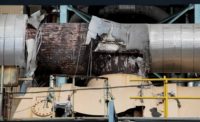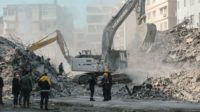Seismic Engineering
Anchorage Building Codes Credited for Limited Damage After Quakes
Why the latest Alaska earthquake didn't wreak more destruction

Back-to-back earthquakes on Nov. 30 cracked and splintered Vine Road and other highways north of Anchorage.
PHOTO BY MARC LESTER/ANCHORAGE DAILY NEWS VIA AP
The magnitudes 7.0 and 5.7 earthquakes that struck Anchorage, Alaska, on Nov. 30 shook buildings and shattered highways, but caused limited structural damage and no reported loss of life, mostly due to the depth and location of the quake’s epicenter, as well as the city and state’s stringent building requirements.
Most buildings in the southern Alaska city of about 300,000 are less than 20-30 years old, and local amendments to the already strict International Building Code further regulate the building of structures in Anchorage, requiring in-depth soil analyses and designs that accommodate seismic loads.
The 7.0 magnitude earthquake hit seven miles north of Anchorage at 8:29 a.m. at a depth of about 27 miles, followed six minutes later by a 5.7 aftershock. The quakes also briefly triggered a tsunami warning.
The event served as a test of seismic design standards established in the decades following a devastating 9.2 magnitude temblor and resulting tsunami in 1964 that killed more than 100 people in the Anchorage area and destroyed several small coastal towns.
“That was a wake-up call for the engineering community,” says Sterling Strait, a member of the Alaska Seismic Hazards Safety Commission. “Up to that point, there had not been a lot of emphasis placed on seismic design.”
Lessons from the 1964 earthquake were applied worldwide, Strait says, driving new developments in soil and structural engineering. The code requires comprehensive soil analysis to estimate possible ground motion and requires reinforced connections between a structure’s beams and columns. Alaska uses the 2012 version of code, and is in the process of adopting the 2018 version.
Anchorage’s location near a subduction zone and its unstable ground pose particular challenges.
“We have problematic soils here in the Anchorage area,” Strait says. “We have a lot of swampland and a lot of clays that tend to liquefy in an earthquake. In this recent event, most of the major damage was due to soil subsidence issues and not structural damage issues.”
In response, Anchorage officials have regularly passed local amendments to strengthen the code, says Robert Scher, a geotechnical adviser to the city and a member of the Alaska Seismic Hazards Safety Commission.
While the International Building Code requires a geotechnical investigation of a prospective building site, Anchorage’s requirements go further.
Engineers must demonstrate the safety of sloped sites under a certain level of shaking, using deep soil borings and downhole testing. The latter technique measures vertical changes in seismic velocity by placing a wave source at the top of a borehole and measuring travel times.
The city is also densely laid with about 50 strong-motion seismometers and a downhole sensor array 800 to 1,000 ft deep, Scher says. “These instruments yield an incredible amount of data, especially after an event such as this.”
Downtown Anchorage has only a few high-rise buildings, none more than 22 stories, while most buildings are 10 stories or less, says Joey Yang, chair of the civil engineering department at the University of Alaska, Anchorage. The city’s Downtown Edge, a residential development under construction in an area of high seismic risk, required repeated geotechnical studies with deeper borings before its foundation design satisfied city requirements.
The Nov. 30 earthquakes severely damaged area roads and highways, especially those north of Anchorage. The Alaska Dept. of Transportation identified 50 damaged locations on state-maintained roads, with eight major sites of damage. Glenn Highway, the major thoroughfare north out of Anchorage, suffered the most damage.
The agency is also conducting technical inspections on 243 bridges in the affected area. The work to repair damaged roadways is complicated by the challenges of paving roads in the winter, the department says.




